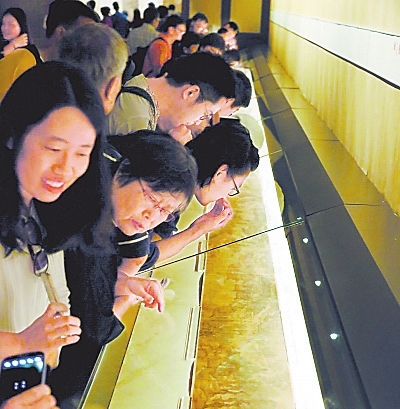
THE fine art masterpiece “Along the River During the Qingming Festival” by 12th-century painter Zhang Zeduan is indisputably the best-known ancient Chinese painting. The 5.28-meter scrolled painting gives a panoramic portrayal of flourishing urban life covering all social classes in Bianliang (today’s Kaifeng in Henan Province), which was the capital of the Northern Song Dynasty (960-1127) at the time. It is now housed in Beijing’s Palace Museum. Museum visitors will be able to take a virtual boat ride along the “river” to get immersed in the prosperous scene of Bianliang, which is displayed in the painting, thanks to digital technology. It is scheduled to open to the public in May. Wang Yamin, deputy director of the Palace Museum and a member of 13th National Committee of the Chinese People’s Political Consultative Conference, revealed the project to China Daily on the sidelines of the two sessions. “People can closely observe the landscape by taking a trip on the water,” he said. “After that, they can do some shopping in Bianliang. We’ll also develop related souvenirs.” The “trip” will last 40 minutes, combining virtual reality and full-dome movie technologies, Wang said. “Making people wear VR glasses for too long will make them dizzy,” he said. “We’ll get rid of the glasses to offer a more comfortable experience.” The Palace Museum, also known as the Forbidden City, was the home of the imperial court from 1420 to 1911. It was the world’s most visited museum last year, with 16.7 million guests. It has 1.86 million artifacts, and its collection accounts for 42 percent of China’s most precious cultural relics. According to Wang, the new project will be in the Archery Pavilion, a hall once used by emperors to practice their archery. In 2015, when “Along the River During the Qingming Festival” last went on display, many people stood in line overnight to see the painting. But the museum’s rules required it to remain in a controlled storage unit for the last three years. He said the new exhibition will wake up the nation’s “sleeping cultural heritage” and make full use of academic progress and digitization technology. “The Palace Museum has a huge collection of precious cultural relics that offer us many inspirations for creativity,” he said. In recent years, the museum was recognized for its popular cultural products and a series of digital platforms, such as a mobile app and online games. Wang said the museum has created nearly 10,000 types of souvenirs, while more than 150 employees are working on developing more souvenirs and digital products. “Higher quantity is not the goal,” he said. “What really matters is high quality.” Nevertheless, he said that as a non-profit public institution, the museum still lacks incentives for employees. “For example, the management system does not allow us to use part of our sales revenue as bonuses,” Wang said. He proposed at the CPPCC session to make amendments to rules supervising public institutions by giving publicly-owned museums greater flexibility in putting more impetus on developing cultural products. (SD-Agencies) | 
